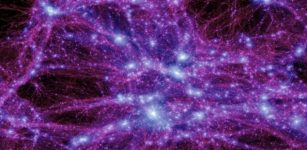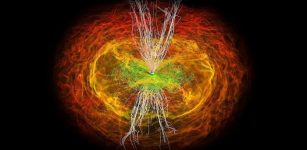‘Fuzzy Universe’ And A Simulation Of Early Galaxy Formation
Eddie Gonzales Jr. – MessageToEagle.com – Now scientists at MIT, Princeton University, and Cambridge University have found that the early universe, and the very first galaxies, would have looked very different depending on the nature of dark matter.
For the first time, the team has simulated what early galaxy formation would have looked like if dark matter were “fuzzy,” rather than cold or warm.
 A simulation of early galaxy formation under three dark matter scenarios. In a universe filled with cold dark matter, early galaxies would first form in bright halos (far left). If dark matter is instead warm, galaxies would form first in long, tail-like filaments (center). Fuzzy dark matter would produce similar filaments, though striated (far right), like the strings of a harp. Image credit: MIT
A simulation of early galaxy formation under three dark matter scenarios. In a universe filled with cold dark matter, early galaxies would first form in bright halos (far left). If dark matter is instead warm, galaxies would form first in long, tail-like filaments (center). Fuzzy dark matter would produce similar filaments, though striated (far right), like the strings of a harp. Image credit: MIT
They found that if dark matter is cold, then galaxies in the early universe would have formed in nearly spherical halos. But if the nature of dark matter is fuzzy or warm, the early universe would have looked very different, with galaxies forming first in extended, tail-like filaments.
In a fuzzy universe, these filaments would have appeared striated, like star-lit strings on a harp.
“The first galaxies in the early universe may illuminate what type of dark matter we have today,” says Mark Vogelsberger, associate professor of physics at MIT’s Kavli Institute for Astrophysics and Space Research, said in a press release.
“Either we see this filament pattern, and fuzzy dark matter is plausible, or we don’t, and we can rule that model out. We now have a blueprint for how to do this.”
While dark matter has yet to be directly detected, the hypothesis that describes dark matter as cold has proven successful at describing the large-scale structure of the observable universe. As a result, models of galaxy formation are based on the assumption that dark matter is cold.
“The problem is, there are some discrepancies between observations and predictions of cold dark matter,” Vogelsberger points out.
The team began each simulation by assuming a certain distribution of dark matter, which scientists have some idea of, based on measurements of the cosmic microwave background — “relic radiation” that was emitted by and was detected just 400,000 years after the Big Bang.
“Dark matter doesn’t have a constant density, even at these early times,” Vogelsberger says.
“There are tiny perturbations on top of a constant density field.”
The researchers used existing algorithms to simulate galaxy formation were able to under scenarios of cold and warm dark matter. Then. they modified their simulation of cold dark matter, enabling it to solve two extra equations in order to simulate galaxy formation in a fuzzy dark matter universe.
Read more – here
Written by Eddie Gonzales Jr. – MessageToEagle.com Staff










![Crystallographic structure of a cuprate Yttrium barium copper oxide, which is a high temperature superconductor. [CC: Julien Bobroff, LPS, Orsay, France]](https://www.messagetoeagle.com/wp-content/uploads/2022/01/superconductmystery1-307x150.jpg)